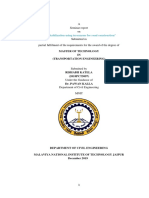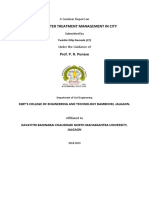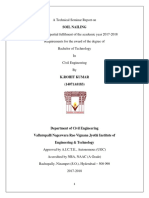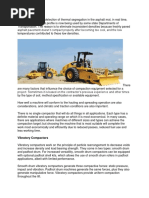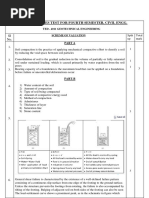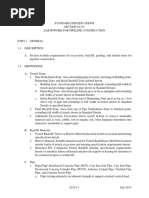Ground Improvement Technique by Grouting: Bachelor of Engineering in Civil Engineering
Ground Improvement Technique by Grouting: Bachelor of Engineering in Civil Engineering
Uploaded by
kiran mCopyright:
Available Formats
Ground Improvement Technique by Grouting: Bachelor of Engineering in Civil Engineering
Ground Improvement Technique by Grouting: Bachelor of Engineering in Civil Engineering
Uploaded by
kiran mOriginal Title
Copyright
Available Formats
Share this document
Did you find this document useful?
Is this content inappropriate?
Copyright:
Available Formats
Ground Improvement Technique by Grouting: Bachelor of Engineering in Civil Engineering
Ground Improvement Technique by Grouting: Bachelor of Engineering in Civil Engineering
Uploaded by
kiran mCopyright:
Available Formats
GROUND IMPROVEMENT
TECHNIQUE BY GROUTING
A seminar report submitted in partial fulfillment for the award of the degree of
Bachelor of Engineering in Civil Engineering
Visveswaraiah Technological University, Belgaum.
By
NACHIKETHAN.K.H
VIII CIVIL
USN- 1NC07CV406
DEPARTMENT OF CIVIL ENGINEERING
NAGARJUNA COLLEGE OF ENGINEERING AND TECHNOLOGY
VISVESWARAIAH TECHNOLOGICAL UNIVERSITY, BELGAUM
BANGALORE-562110
MAY-2010
NCET CIVIL Page 1
DEPARTMENT OF CIVIL ENGINEERING
NAGARJUNA COLLEGE OF ENGINEERING AND
TECHNOLOGY
(AFFILIATED TO VISVESWARAIAH TECHNOLOGICAL UNIVERSITY, BELGAUM)
BANGALORE-562110
CERTIFICATE
This is to certify that ‘GROUND IMPROVEMENT TECHNIQUE BY
GROUTING’ is a bonafied seminar report submitted by Ms NACHIKETHAN.K.H
bearing USN 1NC07CV406 on partial fulfillment for the award of degree, Bachelor of
Engineering, in Civil Engineering of Visveswaraiah Technological University, Belgaum
during the year 2009.
Signature of the HOD
C.Ramakrishne Gowda
Professor
NCET CIVIL Page 2
ACKNOWLEDGEMENT
The satisfaction that accompanies the successful completion of any task would be
incomplete without mentioning of the people who made it possible. Many responsible for
the knowledge and experience gained during the work course.
I would like to express a deep sense of gratitude and indebthness to Sri and Sri
Selection Grade Lectures, Civil Engineering Department, N.C.E.T College of
Engineering, Bangalore, for their constant encouragement, guidance and inspiration,
which enabled me to complete this seminar work.
I would also like to express my gratefulness towards all the faculty members,
Department of Civil Engineering, NCET, Bangalore for their timely suggestions.
I am thankful to Dr. C.Ramakrishne Gowda Professor and Head, Department of
Civil Engineering, for bringing excellent academic climate to finish my work
successfully.
Last but not the least, I express my deepest sense of gratitude for the inspiration,
enthusiasm and help given by my parents and friends.
NACHIKETHAN.K.H
1NC07CV406
VIII SEMISTER
NCET CIVIL Page 3
Abstract
Ground modification techniques have become a major part of civil
engineering practice over the last few decades, and their use is growing rapidly,
as world wide developments pose an increasing demand for land reclamation and
the utilization of soft or unstable soils. Different types of ground modification
techniques are used in practice. The choice of a particular method depends on the soil
which is to be handled. Out of the many techniques, Grouting is one technique of ground
modification adopted as an effective means to improve the properties of saturated, soft
soils. Grouting is a frequently utilized remedy in the planning and implementation of
ground improvement and tunnel rehabilitation practice
The present seminar intends to discuss-
1. Need for ground improvement.
2. Ground improvement technique by Grouting.
3. Principle behind Grouting, merits and demerits of the Grouting technique.
4. Case study depicting the successful implementation of the technique.
NCET CIVIL Page 4
CONTENTS
INTRODUCTION
GENERAL DESCRIPTION ABOUT GROUTING, MERITS AND DEMERITS
TYPES OF GROUTING MATERIAL
METHODS OF GROUTING
GROUTING CONTROL
APPLICATIONS OF GROUT
CASE STUDIES
CONCLUSION
REFERENCES
NCET CIVIL Page 5
INTRODUCTION
What is ground improvement technique?
Ground improvement technique is the process of improving the geo-technical
characteristics of soil used in construction
The soil at a construction site is not always totally suitable for supporting structures
such as buildings, bridges, highways and dams. In granular soils, in-situ soil may be
very loose and indicate large elastic settlement. Under these conditions, soil needs to
be densified to increase its unit weight and shear strength. If top layers of soil are
undesirable, it must be removed and replaced with better soil on which structural
foundation can be built. The fill soil should be well compacted to sustain desirable
structural load. In low-lying areas also, fill may be required to raise the ground
elevation for construction of foundation. Sometimes soft saturated clay layers are
encountered at shallow depths below foundations. Such soils usually undergo large
consolidation settlement depending on the structural load and the depth of the layers.
Special ground improvement techniques are required to minimize settlement under
these conditions. Similarly specific type of soil improvement techniques is required in
the case of expansive soils.
Objectives of ground improvement are to:
(i) Reduce settlement of structures.
(ii) Improve shear strength and bearing capacity of shallow foundations.
(iii) Increase factor of safety against possible slope failure of embankments and
dams.
(iv) Reduce shrinkage and swelling of soils.
NCET CIVIL Page 6
In both seismically active and inactive areas, soil improvement techniques are
commonly used, if existing soil is expected to lead to unsatisfactory performance.
Usually it is in the form of unacceptably large horizontal or vertical (or both)
movements. Consequently, soil improvement techniques are directed towards increasing
strength and stiffness of soil deposits under earthquake conditions. For earthquake
conditions, ground improvement technique is also directed towards reduction in excess
pore pressure generation during ground shaking
TYPES OF GROUND IMPROVEMENT TECHNIQUES
COMPACTION PILE
BLASTING
PRE-COMPRESSION
STONE COLUMN
VIBROFLOATATION
GROUTING
ELECTRO OSMOSIS
THERMAL TREATMENT
GROUTING
Grouting is a process where by fluid like material, either in suspension or in solution
form is injected into subsurface soil or rock to achieve a decrease in permeability and
NCET CIVIL Page 7
compressibility, to improve its strength or to decrease seepage flow. The treatment may
be applied as a preventive measure before construction or as a rehabilitative treatment for
structures suffering post construction distress due to poor soil condition .
Grout is actually a variety of materials used to fill voids, stabilize soil, hold bricks
in place, coat cement, and prevent infiltration. Grouts are applied under pressure after the
pipe has been adequately cleaned to provide a good work surface. A typical grouting
application in new construction is to seal the joints between segmented concrete pipes. A
common use in rehabilitation is to seal off groundwater infiltration in no pressure
pipelines. Since grouting can be placed wet, it adapts well to irregular surface.
Limitations and Advantages of Grout
Limitations Advantages
Not a structural repair Stops groundwater from
Leaking in
Requires highly skilled operators Stabilizes soil
Difficult to seal actively infiltrating joint Fills void around pipe
Packer will not seal properly in badly Is a long-term, inexpensive
Corroded pipe trenchless technology
Not for small- or large-diameter pipe well suited to 10- to 15-in.
pipe
Can make small cracks bigger
NCET CIVIL Page 8
Pipe must be thoroughly cleaned and in good
Condition (no protruding taps or broken
Sections)
The most common grouts available are made of acryl amide gel, acrylic gel, acryl ate gel,
urethane gel, and polyurethane foam. The difference between grouts is largely due to
reaction times. Shorter gel times are better suited for actively leaking joints. Some grouts
use a chemical catalyst; others use groundwater to trigger the chemical reaction.
Cementations grouts are injected through leaky joints to minimize infiltration.
Chemical grouts are used to seal minor leaks and cracks. Chemical grout is not a
structural repair, but is used to stabilize surrounding soil and prevent groundwater
infiltration. Water- activated chemical grout is pushed out of the pipe through joints and
small cracks. It sets up outside the affected joint and plugs the gap.
Grouting is used in trench less applications to stop infiltration, stabilize voids and fill the
annular space between the host pipe and liner pipe. Although there are many different
types of grouting materials, they may be generally classified into two groups: chemical
and cementations. Cementations grouting includes the injection of micro fine cements
and mixing of Portland, soil and/or fly ash with chemical grouts. These grout materials
are injected to eliminate infiltration and stabilize soil voids. There are patented methods
available. After a pipe has been renewed through re-lining, grout may be used to stabilize
the liner by grouting the annular space remaining after insertion. These requirements vary
by manufacturer, whose recommendations should be followed.
AIMS OF GROUTING
To increase resistance against deformation
To supply cohesion
To reduce conductivity and interconnected porosity
To decrease the permeability.
To increase the shear strength.
To decrease the compressibility
NCET CIVIL Page 9
GROUT PROVES MORE EFFECTIVE IN THE FOLLOWING CASES
When the foundation has to be constructed below ground water table.
When there is difficult to the foundation level (ex: city work, tunnel shafts, sewers,
subway construction).
When the geometric dimensions of the foundations are complicated and
involved many boundaries and contact zones.
When the adjacent structure require that the soil of the foundation strata should
not be excavated
CLASSIFICATION OF GROUT MATERIALS
A large variety of materials can be used for grouting; the selection depends on
requirements of durability, penetration, and strength. Grout materials are classified as
follows.
SUSPENSION GROUT (or cementations grout)
EMULSION GROUT
SOLUTION GROUT
SUSPENSION GROUT
This type comprises of mixtures cement plus water and other particulate solids such as
clay, fly ash, lime, asphalt emulsion etc. such type of mixtures depending on their
compositions, may prove to be stable(i.e., have minimal bleeding) or unstable when left
at rest .Stable grouts have both cohesion and plastic viscosity, increasing with time.
These suspensions are injected into soil mass to promote permeation. While doing the
permeation of suspension grout, importance has to be given to the grout ability ratio
(GR),
GR= (d15 (Formation)/d85 (Grout))>20
One of the most commonly adopted suspension grout is cement grout
NCET CIVIL Page 10
EMULSION GROUT
Colloidal solutions, evaluative Newtonian fluids in which viscosity progressively
increases with time.
Ex: sodium silicate based
SOLUTION GROUT
Pure solutions, nonevolutive Newtonian solutions in which viscosity is essentially
constant until setting, within a controlled period.
The liquid homogeneous molecular mixtures of two or more substances are solution
grout.
Ex: organic resins and a wide variety of chemical grouts
NCET CIVIL Page 11
PRINCIPLE TYPES OF GROUT
NCET CIVIL Page 12
LIMITATIONS OF CHEMICAL GROUT
With chemical grouts, toxicity and permanency have also become an issue.
Permanency refers to the resistance against mechanical deterioration due to
freeze-thaw or wetting and drying cycles and chemical degradation by reaction with the
ground water or soil constituents.
Toxicity refers to health hazards in handling the grout and its effects on the
quality of the groundwater it is in contact with.
NCET CIVIL Page 13
Unfortunately, the high-strength, high permanent grouts seem to present the
greatest risk with respect to handling, ground water pollution, and corrosion
TYPES OF GROUTING
PENETRATION OR PERMREATION GROUTING
DEFINITION:
Penetration grouting describes the process of filling joints or fractures in rock or pore
spaces in soil with a grout without disturbing the formation. Permeation Grouting is
defined as a means of impregnating the voids within a soil or rock mass and thereby
displacing water and air from the voids and replacing it with grout, without displacing the
soil particles or widening the existing fissures in the rock.
Grouts are required to have high levels of fluidity and stability and in the case of high
penetration particular grouts, contain extremely fine particles. Grout materials include, by
diminishing void size: cement based grouts with filler or foaming additives, cement,
betonies/cement, betonies/cement with high penetration additives, micro fine cement,
silica gels and resins.
The principal purposes of permeation grouting are for waterproofing and strengthening
the soil or rock and limitations are encountered only where voids become too small to
allow grout penetration, at which point in the case of soils, alternative methods of
treatment should be considered.
Permeation Grouting is strictly a low pressure operation aimed at impregnation of the soil
or rock. Elevated pressures that exceed the lowest principal stress at the point of injection
in the soil cause ‘Claquage,’ where a fissure in the soil is opened in a plane perpendicular
to the minimum principal stress defeating the objective of impregnation. In rock, elevated
NCET CIVIL Page 14
pressure in grout will encourage destabilization and segregation, resulting in decreased
effectiveness of the grouting process. Pressures must be contained to avoid these
phenomena.
Advantages
Controlled and accurate placement.
Economical cost.
Significant and predictable degrees of improvement.
Non-vibratory.
Limited workspace require
NCET CIVIL Page 15
COMPACTION GROUTING
Compaction grouting is the injection of grout into the soil to improve bearing capacity.
This is accomplished by using high pressure to expand a bulb of very low slump grout in
a controlled manner through an injection pipe. The process has been used successfully for
foundation improvement as a precautionary measure under new construction and for
remediation of structures that have settled.
The process of compaction grouting consists of installation of injection pipes to the
bottom of the zone being densified. The pipes are either drilled or driven into place with a
sacrificial point. The pipe is withdrawn to open the end of the injection pipe. A specially
designed low volume, high pressure pump is used to place the grout. As the grout
expands in a homogeneous bulb, the radial force exerted compacts the surrounding soils.
A relatively slow injection rate is used to prevent fracturing the soils, allowing water to
dissipate and thereby reduce uplift. Injection continues until either refusal pressure is
attained or heaving occurs at the surface. Grout placement continues at shallower
elevations as the injection pipe is withdrawn in stages.
The upward component of force causing heaving at the surface usually limits the degree
which soil can be compacted. Precise laser monitoring equipment detects any surface
movement. Structures can be re-leveled utilizing compaction grouting. With the use of
conventional surveying equipment and laser levels, the surface movement created can be
used to raise structures to precise tolerances.
The soils best suited to compaction grouting are fine grained with sufficient permeability
to allow excess water to dissipate. The process has also been used successfully in a wide
variety of soils and fills. Irregular fills or varying native soils will become more uniform
with compaction grouting. An advantage of compaction grouting is the tendency to
improve the weakest soils. The effective radius of the grout hole varies with the type of
soil being treated. Where large areas are being treated, the primary hole pattern is a
diamond or square pattern with holes on 5 to 10 feet (1.5 to 3 meters) centers. Secondary
or check holes are placed to the center of the pattern.
NCET CIVIL Page 16
Compaction Grouting Geo technical Consideration
The insitu vertical stress in the treatment stratum must be sufficient to enable
the grout to displace the soil horizontally.
The grout injection rate should be slow enough to allow pore pressure
dissipation.
Collapsible soils can usually be treated effectively with the addition of water
during drilling prior to compaction grout injection.
NCET CIVIL Page 17
Advantages of compaction grouting
Pinpoint treatment
Speed of installation
Effective in a variety of soil conditions
Can be performed in very tight access & low headroom condition
Non-hazardous
No waste spoil disposal
Non-destructive & adaptable to exiting foundations
Able to reach depths unattainable by other methods
HYDROFRACTURE GROUTING
Definition:
If the grouting pressure is greater than the tensile strength of the soil or rock being
grouted, the soil or rock fails resulting in fractured zone. The grout penetrates this
fractured zone forming densified region of soil or rock masses.
The ground is deliberately split by injecting stable but fluid cement-based grouts at high
pressures (e.g., up to 4 MPa).the lenses sheets of grout so formed are thought to increase
total stress, fill unconnected voids, possibly consolidate the soil locally, and,
NCET CIVIL Page 18
conceptually, create mainly horizontal, impermeable barriers. However, hydro fracture
grouting’s effects are difficult to control, and the potential danger of damaging adjacent
structures by the use of high pressure often proves prohibitive. Hydro fracture naturally
occurs with conventional cement-based grouts in soil with a permeability of less than
10^-1 cm/sec.
Advantages of Hydro fracture grouting system
The control of settlement is carried out from outside the building and hence there
is no disruption to the occupants
The process can be repeated allowing continued control of settlement (if required)
NCET CIVIL Page 19
JET GROUTING
Jet, or replacement, grouting is the youngest major category of ground treatment.
According to Miki and Nakanishi (1984), the basic concept was propounded in Japan in
1965,but it is generally agreed that it is only since the early 1980s that the various
derivatives of jet grounding have approached their full economic and operational
potential to the extent that today it is arguably the fastest growing method of ground
treatment worldwide. Its development was fostered by the need to thoroughly treat soils
ranging from gravels to clays to random fills in areas where major environmental controls
were strangle\y exercised over the use of chemical (permeation) grouts and allowable
ground movements.
Jet grouting can be executed in soils with a wide range of granulometries and
permeabilities.Indeed, any limitations to its applicability are imposed by other spoil
parameters (eg. the shear strength of cohesive soils or the density of granular deposits) or
by economic factors.
The ASCE Geotechnical Engineering Division Committee on grouting defined Jet
grouting as a “technique utilizing a special drill bit with horizontal and vertical high
speed water jets to excavate alluvial soils and produce hard impervious column by
pumping grout through the horizontal nozzles that jets and mixes with foundation
material as the drill bit is with drawn”.
Advantages
Nearly all soil types grout able
Designable strength & permeability
No harmful vibrations
Can be performed in limited workspace
NCET CIVIL Page 20
Maintenance free
Safest method of under pinning construction
Much faster than alternative method
GROUTING CONTROL
Monitoring the grout taken as a function of pressure
Observing ground heave
Digging inspection pits
Retrieving Core samples for examination and laboratory testing
Conducting borehole permeability tests
APPLICATIONS
Control of ground water during construction.
Void filling to prevent excessive settlement.
Strengthening adjacent foundation excavation, pile
Drilling etc
.
Soil strengthening to reduce lateral support requirements.
Stabilization of loose sands against liquefaction.
Foundation underpinning.
NCET CIVIL Page 21
Reduction of machine foundation vibrations.
CASE STUDIES
CASE STUDY-1
Kraft Foods – Dover, Delaware
For construction of a 20 ft (6m) deep railcar unloading pit within an existing building, jet
grouting performed three functions: excavation support, underpinning, and grout
control to meet project performance objectives, a bathtub configuration was constructed
via perimeter wall of 20 ft deep, interconnected jet grouted columns enclosing a 6ft thick
jet grouted base.
The perimeter columns provided excavation support while those at corners of pit also
underpinned the existing adjacent footing. The jet grouting program successfully prevent
building movement and vertical and horizontal ground water infiltration.
NCET CIVIL Page 22
CASE STUDY-2
Dales ford lake development –Berwyn, Pennsylvania
A luxury, four unit town house structure founded on timber piles had exhibited structural
distress related to sink whole activity. Surface investigation revealed 5-30ft of
miscellaneous fill, including wood chips and building materials, overlaying clay soil.
Beneath this, pinnacled karastic lime stone was encountered at depths ranging between
10 and 30ft.Grout pipes were installed at 68 interior, low head room locations and 90
exterior locations, to an average depth of 16 to 21ft. Compaction grouting was performed
to stabilize the driven pile foundation, re-establish ground contact with the structure, and
halt the soil piping that had resulted from sink hole activity. The work was successfully
completed while the building remained occupied.
NCET CIVIL Page 23
CONCLUSION
> Many engineers still consider this grouting technique as a art rather than science.
> Its successful application requires great deal of experience, thorough knowledge
of geological condition and awareness of equipment capabilities and limitations.
> The overall success of grouting technology is less than 50% of intended goals.
> Is a long-term, inexpensive trench less technology
NCET CIVIL Page 24
REFERENCES
http://www.austressmenard.com.au/permation_grouting.php
http://www.judycompany.com/compaction_grouting.htm
Ground Improvement by M.P.Moseley
Koerner, R. M, (1985) construction and Geotechnical Methods in
Foundation Engineering, McGraw Hill Book Company, Newyork.
Hausmann, M.R, (1990), Engineering Principles of Ground Modification.
McGraw Hill Publishing Company, Newyork.
www.hayward baker.com
NCET CIVIL Page 25
You might also like
- A Case Study On Ground Improvement Techniques and Its ApplicationsDocument18 pagesA Case Study On Ground Improvement Techniques and Its Applicationsmennahossam8820100% (1)
- Highway Lab ReportDocument23 pagesHighway Lab ReportGayan WaidyaratneNo ratings yet
- Reinforced Concrete Grade Beams, Piles & Caissons: A Practical Guide for Hillside ConstructionFrom EverandReinforced Concrete Grade Beams, Piles & Caissons: A Practical Guide for Hillside ConstructionNo ratings yet
- Visvesvaraya Technological University, BelagaviDocument27 pagesVisvesvaraya Technological University, BelagaviRachitha PrachithaNo ratings yet
- A Project Report Water Absorbing Pavements by Using Porous ConcreteDocument17 pagesA Project Report Water Absorbing Pavements by Using Porous ConcreteAbhinandan PatilNo ratings yet
- Underwater ConcretingDocument31 pagesUnderwater Concretingshivakumar83% (12)
- Final Technical Seminar Report PDFDocument30 pagesFinal Technical Seminar Report PDFKumarNo ratings yet
- Major ProjectDocument18 pagesMajor ProjectAwesomeNo ratings yet
- Ground Improvement Techniques by GroutingDocument16 pagesGround Improvement Techniques by GroutingYathish143100% (2)
- Water Absorbing Pavements by Using Porous Concrete: A Project ReportDocument17 pagesWater Absorbing Pavements by Using Porous Concrete: A Project ReportSɪᴅᴅʜᴀɴᴛ Sᴀɢᴀʀ100% (1)
- Soil NailingDocument26 pagesSoil NailingBobby AustinNo ratings yet
- CT Tutorial3Document6 pagesCT Tutorial3Jon KokNo ratings yet
- Porous ConcreteDocument23 pagesPorous ConcreteSunanda Desai Ramteerth100% (1)
- Self Curing PDFDocument26 pagesSelf Curing PDFlingarajNo ratings yet
- "Improvement of Compressive Strength of Pervious Concrete": Narayana Engineering CollegeDocument79 pages"Improvement of Compressive Strength of Pervious Concrete": Narayana Engineering CollegeShiva AnusuruNo ratings yet
- Elbadry 2016Document10 pagesElbadry 2016Juan Camilo PinedaNo ratings yet
- Final Correction My Bhokar SiteDocument26 pagesFinal Correction My Bhokar SiteMd IsmailNo ratings yet
- Ground Improvement Techniques by Grouting A.I.T.ChikmagalurDocument20 pagesGround Improvement Techniques by Grouting A.I.T.ChikmagalurJayakumarNo ratings yet
- INTERNSHIP PresentationDocument12 pagesINTERNSHIP Presentation1rn19cv039.shanthakumarmNo ratings yet
- Construction of Residential Building: A Practical Traning Report ONDocument34 pagesConstruction of Residential Building: A Practical Traning Report ONlokesh nagarNo ratings yet
- Rural Development Construction.Document41 pagesRural Development Construction.Anuj SubbaNo ratings yet
- Summer Internship Report Srmu Civil Engineering DepartmentDocument21 pagesSummer Internship Report Srmu Civil Engineering DepartmentDIVYANSHI PHOTO STATE100% (1)
- Analysis For Best Construction Site in Lucknow and Their Improvement TechniquesDocument72 pagesAnalysis For Best Construction Site in Lucknow and Their Improvement TechniquesSTAR PRINTINGNo ratings yet
- My Swep Report-12Document17 pagesMy Swep Report-12ikouwemsunday156No ratings yet
- Thesis CPPDocument40 pagesThesis CPPParth KshirsagarNo ratings yet
- TERRAZYME Seminar With Page No ReportDocument17 pagesTERRAZYME Seminar With Page No ReportAbhinav DhayalNo ratings yet
- Visvesvaraya Technological University BELAGAVI-590018: Seminar Report On White Topping On Bituminous RoadDocument43 pagesVisvesvaraya Technological University BELAGAVI-590018: Seminar Report On White Topping On Bituminous RoadRutu YalasangiNo ratings yet
- Jaga ReportDocument22 pagesJaga Reportsatyaranjandhal069No ratings yet
- Compressive Strength of Pervious ConcreteDocument79 pagesCompressive Strength of Pervious ConcreteShaik Chandinii100% (1)
- Advancement Techniques in Underground Structures: Seminar ReportDocument14 pagesAdvancement Techniques in Underground Structures: Seminar ReportAbilash GdsNo ratings yet
- Underwater Concret inDocument11 pagesUnderwater Concret inPavan GajulaNo ratings yet
- 93DSS JRP JJBIJETTIJETT V4I8P141Volume4Issue8 August2013Document6 pages93DSS JRP JJBIJETTIJETT V4I8P141Volume4Issue8 August2013Arham SheikhNo ratings yet
- DE A1Document21 pagesDE A1manasiyatalha6003No ratings yet
- Thesis cpp-1Document31 pagesThesis cpp-1Parth KshirsagarNo ratings yet
- Underwater ConstructionDocument22 pagesUnderwater ConstructionMayur DeshmukhNo ratings yet
- Sandhya Doc FinalDocument25 pagesSandhya Doc FinalSandhyaNo ratings yet
- Ijsei 44015 11Document4 pagesIjsei 44015 11Yash KapadiyaNo ratings yet
- Vacuum Dewaterimg: New Way For Concrete Flooring by Tremix MethodDocument9 pagesVacuum Dewaterimg: New Way For Concrete Flooring by Tremix MethodRAMEES MAJEEDNo ratings yet
- Title and chp1 &2Document11 pagesTitle and chp1 &2sohailahmad.com990No ratings yet
- VACCUM DEWATERED FLOORING-1-converted FinalDocument20 pagesVACCUM DEWATERED FLOORING-1-converted FinalSachin50% (2)
- Jain ReportDocument25 pagesJain Reportsachin sNo ratings yet
- Mini Project ReportDocument26 pagesMini Project Report4NM19CV009 ANIRUDH N TANTRYNo ratings yet
- Investigation On Causes of Pavement Failure and Its Remedial MeasuresDocument5 pagesInvestigation On Causes of Pavement Failure and Its Remedial MeasuresIJRASETPublicationsNo ratings yet
- fin plag (1)Document12 pagesfin plag (1)2021810148.subodhNo ratings yet
- REPORT Revie-1Document36 pagesREPORT Revie-1G Varun DevNo ratings yet
- Project Report Group 24Document21 pagesProject Report Group 24kccvinodkNo ratings yet
- Government Polytechnic Jalna: ND ConstructionDocument26 pagesGovernment Polytechnic Jalna: ND Constructionpranavingale2007No ratings yet
- Cec 410Document38 pagesCec 410Brams PeterNo ratings yet
- Department of Civil Engineering: "High Perfomance Concrete"Document5 pagesDepartment of Civil Engineering: "High Perfomance Concrete"kiswah computersNo ratings yet
- A Review On Ground Improvement Techniques To Improve Soil Stability Against LiquefactionDocument4 pagesA Review On Ground Improvement Techniques To Improve Soil Stability Against LiquefactionRami Mahmoud BakrNo ratings yet
- Shotcrete Concrete TechnologyDocument21 pagesShotcrete Concrete TechnologyNitesh Singh75% (4)
- Grouting and InjectionDocument5 pagesGrouting and InjectionLeema KNo ratings yet
- Seminar Madhu_pagenumberDocument23 pagesSeminar Madhu_pagenumberpriyabrataofficial03No ratings yet
- V12I347Document8 pagesV12I347Manglemnganba LaishramNo ratings yet
- EXPERIMENTAL INVESTIGATION ON MAXIMUM STRENGTH OF PERVIOUS CONCRETE BY VARYING SIZE OF AGGREGATES (Krishnan Unni. S)Document18 pagesEXPERIMENTAL INVESTIGATION ON MAXIMUM STRENGTH OF PERVIOUS CONCRETE BY VARYING SIZE OF AGGREGATES (Krishnan Unni. S)Krishnan Unni S Pillai (कृष्णनुण्णि)No ratings yet
- A Study On Ground Improvement Using Stone Column Techanique: Number NameDocument34 pagesA Study On Ground Improvement Using Stone Column Techanique: Number Namekrunalshah1987No ratings yet
- Tociej 15 310Document10 pagesTociej 15 310DownNo ratings yet
- CANAL LINING SEMINAR REPORT PrakashDocument10 pagesCANAL LINING SEMINAR REPORT PrakashChirag SolankiNo ratings yet
- TOP DOWN CRACKING IN BITUMINOUS PAVEMENT by MD - IMTHIYAZDocument48 pagesTOP DOWN CRACKING IN BITUMINOUS PAVEMENT by MD - IMTHIYAZMd.imthiyaz40% (5)
- Soil Investigation and Foundation DesignFrom EverandSoil Investigation and Foundation DesignRating: 4.5 out of 5 stars4.5/5 (9)
- Ibb Mcup & Modification of K-12 Building: Safco/Ibb Mobile Coating Unit PojectDocument19 pagesIbb Mcup & Modification of K-12 Building: Safco/Ibb Mobile Coating Unit PojectShewale PravinNo ratings yet
- Astm D4718 D4718M 15Document3 pagesAstm D4718 D4718M 15mdsobahanmunsi39No ratings yet
- SAB 3122 10 ExcavationDocument26 pagesSAB 3122 10 ExcavationNSBMRNo ratings yet
- Measuring Stiffness and Apparent Modulus of Soil and Soil-Aggregate In-Place by An Electro-Mechanical MethodDocument5 pagesMeasuring Stiffness and Apparent Modulus of Soil and Soil-Aggregate In-Place by An Electro-Mechanical MethodAriel BedoyaNo ratings yet
- No-Fines Pervious Concrete For Paving by Richar C. Meininger - 1988Document8 pagesNo-Fines Pervious Concrete For Paving by Richar C. Meininger - 1988NidDouNo ratings yet
- Field Density Test Item No.Document2 pagesField Density Test Item No.Johnrel BanagaNo ratings yet
- TENDER # PROC-LF/PT/PROD-SERV/16876/2017: Bidding DocumentDocument234 pagesTENDER # PROC-LF/PT/PROD-SERV/16876/2017: Bidding Documentmc160403810 Usman AliNo ratings yet
- DynamicCompaction PDFDocument2 pagesDynamicCompaction PDFChowdhury PriodeepNo ratings yet
- Comparing The Conventional Soil Stabilization Methods To The Consolid System Used As An Alternative Admixture Matter in Isparta Dar-Dere Material PDFDocument9 pagesComparing The Conventional Soil Stabilization Methods To The Consolid System Used As An Alternative Admixture Matter in Isparta Dar-Dere Material PDFJean PajueloNo ratings yet
- Dry Density of Soil by Sand Replacement MethodDocument3 pagesDry Density of Soil by Sand Replacement MethodAfthal AhamedNo ratings yet
- Wick DrainsDocument2 pagesWick Drainsdarkobogd75No ratings yet
- Experiment No. 5 Unit Weight and Voids of Coarse AggregatesDocument7 pagesExperiment No. 5 Unit Weight and Voids of Coarse AggregatesMeriann May Sacayan DivinagraciaNo ratings yet
- AGPT-T053-07 Repeated Load Triaxial PDFDocument29 pagesAGPT-T053-07 Repeated Load Triaxial PDFThomasJohnnoStevenson100% (1)
- CompactorsDocument4 pagesCompactorsPiyal Mendis100% (1)
- Otech Lab Mannual by Salik Haroon AbbasiDocument185 pagesOtech Lab Mannual by Salik Haroon AbbasiAmmar Ahmad EEDNo ratings yet
- Omc & MDDDocument35 pagesOmc & MDDsuraj ChinttuNo ratings yet
- Civil Engineering Question and AnswersDocument20 pagesCivil Engineering Question and AnswersUnique Boy100% (2)
- Geotech Engg QuestionsDocument2 pagesGeotech Engg QuestionsYashasviNo ratings yet
- 2024 Second Series - Scheme of ValuationDocument5 pages2024 Second Series - Scheme of ValuationDIVYA NATHNo ratings yet
- Astm-D6938-15 DensimetroDocument9 pagesAstm-D6938-15 DensimetroAlex SalgadoNo ratings yet
- Moisture Lnduced Damage: Resistance of Compactad Asphalt Mixture ToDocument8 pagesMoisture Lnduced Damage: Resistance of Compactad Asphalt Mixture ToGabith Quispe ApazaNo ratings yet
- LGED Schedule of Rates 2022 - FB - Design - IntegrityDocument442 pagesLGED Schedule of Rates 2022 - FB - Design - IntegrityAsit MondalNo ratings yet
- Road Construction MethodsDocument163 pagesRoad Construction MethodsVetcher Columna100% (1)
- Assignments 1 and 2 - 2017 MemoDocument7 pagesAssignments 1 and 2 - 2017 Memonyashadzashe munyatiNo ratings yet
- Recycled Glass Utilization in Highway Construction Isaac Finkle, GRA, EITDocument25 pagesRecycled Glass Utilization in Highway Construction Isaac Finkle, GRA, EITUsama HeneashNo ratings yet
- Lab. EquipmentDocument12 pagesLab. EquipmentSk Sabir HossainNo ratings yet
- Sub GradeDocument12 pagesSub GradeMiaNo ratings yet
- Earthwork For Pipeline Construction 2015Document19 pagesEarthwork For Pipeline Construction 2015elkanitNo ratings yet
- Final Jet GroutingDocument10 pagesFinal Jet GroutingHaresh ReddyNo ratings yet

























